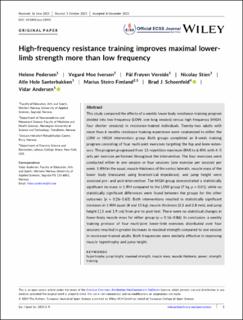| dc.description.abstract | This study compared the effects of a weekly lower body resistance-training program divided into low frequency (LOW, one long session) versus high frequency (HIGH, four shorter sessions) in resistance-trained individuals. Twenty-two adults with more than 6 months resistance training experience were randomized to either the LOW or HIGH intervention group. Both groups completed an 8-week training program consisting of four multi-joint exercises targeting the hip and knee extensors. The program progressed from 12-repetition maximum (RM) to 6-RM, with 4–5 sets per exercise performed throughout the intervention. The four exercises were conducted either in one session or four sessions (one exercise per session) per week. 1-RM in the squat, muscle thickness of the vastus lateralis, muscle mass of the lower body (measured using bioelectrical impedance), and jump height were assessed pre- and post-intervention. The HIGH group demonstrated a statistically significant increase in 1-RM compared to the LOW group (7 kg, p = 0.01), while no statistically significant differences were found between the groups for the other outcomes (p = 0.26–0.63). Both interventions resulted in statistically significant increases in 1-RM squat (8 and 15 kg), muscle thickness (2.3 and 2.8 mm), and jump height (1.5 and 1.9 cm) from pre-to post-test. There were no statistical changes in lower-body muscle mass for either group (p = 0.16–0.86). In conclusion, a weekly training protocol of four multi-joint lower-limb exercises distributed over four sessions resulted in greater increases in maximal strength compared to one session in resistance-trained adults. Both frequencies were similarly effective in improving muscle hypertrophy and jump height. | en_US |

